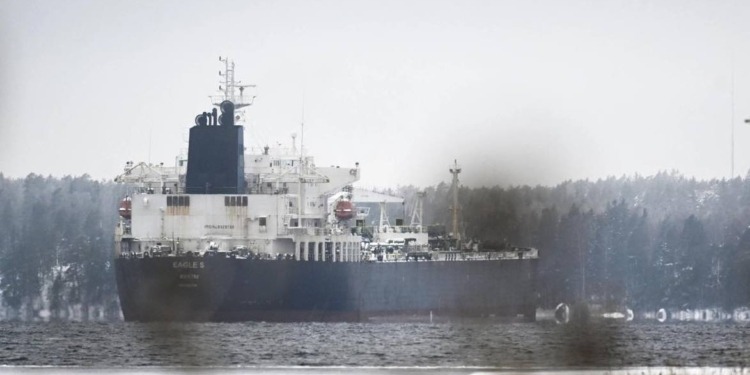A vast and elusive fleet of aging oil tankers has become a major disruptor in the global oil market, operating in secrecy to transport Russian crude in defiance of Western sanctions. This so-called “ghost fleet” has emerged as a vital lifeline for Moscow’s energy exports, but its impact extends far beyond Russia, complicating enforcement efforts, straining regulatory oversight, and introducing new risks to maritime safety and environmental security.
The ghost fleet’s rise began in 2022 after the United States, European Union, and G7 imposed a $60 per barrel price cap on Russian crude exports. These measures were designed to limit Russia’s revenue while ensuring global supply remained steady. To enforce the cap, Western insurers, shipping companies, and financial institutions were barred from providing services to Russian oil shipments that exceeded the limit. Instead of crippling Russia’s oil trade, the restrictions have given rise to an intricate web of middlemen, aging vessels, and opaque ownership structures that now move millions of barrels of crude each day beyond the reach of regulators.
The ships in this fleet, many of them more than 20 years old and originally flagged in Europe or the United States, have since been sold to undisclosed buyers and re-registered under flags of convenience, often in jurisdictions with weak regulatory oversight. The fleet is estimated to number around 600 vessels, according to industry sources, and employs various evasive tactics to remain undetected. These include frequent name changes, disabling of Automatic Identification Systems (AIS) that track ship movements, and ship-to-ship oil transfers conducted in remote waters. Such strategies allow Russian oil to flow largely unimpeded to buyers in Asia, particularly China and India, both of which have become significant markets for discounted Russian crude.
This clandestine trade has upended traditional shipping routes and created logistical challenges for regulators and legitimate oil traders alike. Officials in the U.S. and Europe have struggled to enforce sanctions as vessels change ownership and disappear into the complex network of shell companies set up to obscure their true controllers. The ghost fleet’s activities have also placed pressure on key maritime chokepoints such as the Danish Straits, the Turkish-controlled Bosporus, and the narrow waters around Singapore, where illicit ship-to-ship oil transfers often take place. The scale of the operation has become so vast that major energy analysts say the ghost fleet is now responsible for transporting nearly one-fifth of Russia’s total oil exports.
For legitimate operators in the global oil market, the fleet’s existence has created significant uncertainties. The price cap system was intended to maintain a degree of predictability in oil trade by allowing Russian oil to continue flowing under strict conditions. Instead, it has fostered an unpredictable and opaque parallel trade where risk is poorly understood and oversight is practically nonexistent. Some shipping firms and oil traders now hesitate to engage in transactions involving Russian crude, fearing regulatory penalties or unwitting entanglement with a sanctioned entity.
The environmental risks posed by the ghost fleet are equally concerning. Many of the vessels being used to transport Russian oil would have been retired years ago due to their age and declining seaworthiness. Now, without access to Western insurers or classification societies that conduct safety inspections, these ships continue to operate with minimal oversight. Recent incidents highlight the dangers: in December 2024, two Russian tankers sank in the Kerch Strait near Crimea, raising alarms about potential oil spills. Industry experts warn that as these vessels continue to age and remain uninspected, the risk of accidents and major environmental disasters will grow.
The lack of reputable insurers willing to cover these vessels has led to another consequence: the rise of unregulated or poorly capitalized insurers willing to step in. Some insurance companies, particularly in Russia and China, have filled the void left by Western firms, but their ability to cover major liabilities in the event of spills or accidents remains in question. Many of these firms operate without the financial backing required to handle billion-dollar claims that could arise from maritime disasters.
One striking examples of the complexities facing the insurance sector is the case of Ingosstrakh, a major Russian insurer. In January 2025, the U.S. Department of the Treasury’s Office of Foreign Assets Control (OFAC) imposed sanctions on Ingosstrakh, accusing it of providing coverage to vessels in the ghost fleet. The company, however, argues that it has been unfairly targeted. It claims to have actively refused or canceled coverage for over 100 suspect vessels since 2022 and insists that it was sanctioned for insuring a ship before it became part of the ghost fleet. Ingosstrakh has warned that such measures do more harm than good by forcing even semi-legitimate insurers out of the market, leaving a vacuum to be filled by entities with little capacity or intent to ensure compliance. The company has also expressed concerns that the departure of established insurers will ultimately undermine maritime safety, increasing the likelihood of environmental and financial disasters.
As authorities in Europe and the United States seek ways to tighten enforcement, industry observers note that completely dismantling the ghost fleet will be a difficult task. The sheer scale of the network, combined with the willingness of buyers to circumvent sanctions, suggests that Russia will likely continue exporting oil through unconventional channels. Some Western officials have floated proposals to impose stricter tracking and compliance measures on maritime operators passing through key transit zones, but implementing such controls at a global scale presents enormous logistical and political challenges.
For now, the ghost fleet remains an unpredictable and disruptive force in global oil trade. It has exposed weaknesses in the West’s sanctions enforcement, created a fragmented insurance landscape, and raised serious environmental concerns. As long as there is demand for Russian crude and a network willing to operate in the shadows, the ghost fleet will continue to shape the world’s energy flows, operating just beyond the reach of regulators.































Discussion about this post